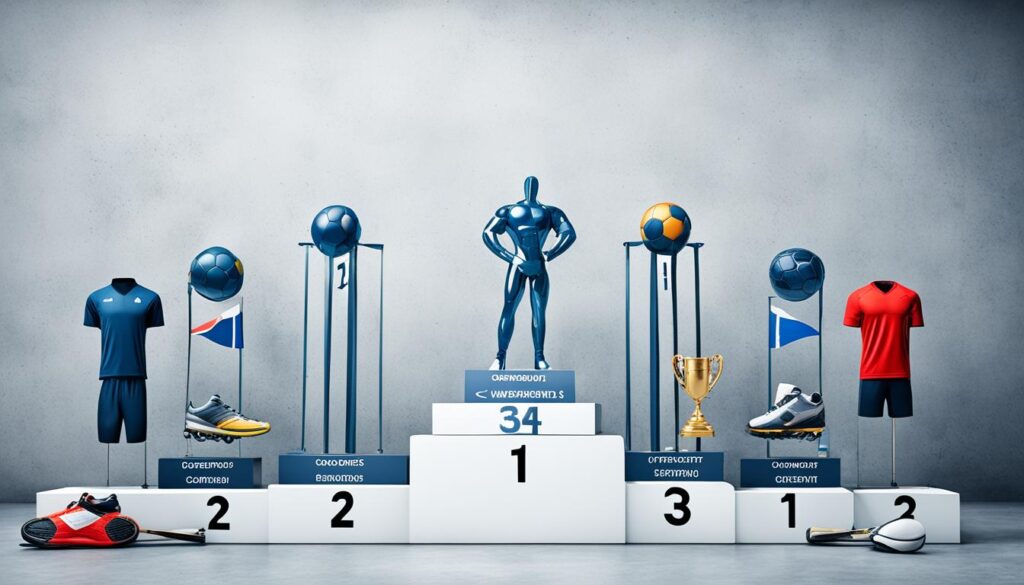Achieve Your Peak: Goal Setting in Sports

“Success is not the key to happiness. Happiness is the key to success. If you love what you are doing, you will be successful.” – Albert Schweitzer
Goal setting is a powerful psychological strategy that can help athletes achieve peak performance in sports. It not only influences athletes’ performances but also positively impacts motivation and confidence. Coaches and parents can teach goal-setting techniques to young athletes to help them map their road to success. The ABCs of goal setting are that goals should be achievable, believable, and athletes should be committed to them. Process goals, which focus on the actual acts of performance, are more effective than outcome goals that focus on the product of performance. Setting process goals in small increments and achieving short-term goals can lead to long-term success. However, there can be challenges in goal setting, such as setting too many goals too soon or setting goals that are too general. It is important to prioritize goals and focus on the most important ones. By implementing a systematic approach to goal setting, athletes can experience the benefits and improve their performance.
Key Takeaways:
- Goal setting is a powerful psychological strategy for athletes to achieve peak performance in sports.
- Process goals, focusing on the acts of performance, are more effective than outcome goals.
- Setting achievable and committed goals is crucial for success.
- Challenges in goal setting include setting too many goals too soon or setting goals that are too general.
- By implementing a systematic approach to goal setting, athletes can improve their performance and reach their potential.
Importance of Goal Setting in Sports for Athletes
Goal setting is of utmost importance in sports for athletes. It serves as a guiding compass, providing direction and purpose in their athletic journeys. By setting clear and meaningful goals, athletes can enhance their performance, boost their motivation, and ultimately reach their full potential.
One of the key benefits of goal setting in sports is its ability to keep athletes motivated and focused on areas of improvement. Goals act as stepping stones, highlighting specific aspects of their training, nutrition, and lifestyle that require attention. By channeling their efforts towards these areas, athletes can make meaningful progress and elevate their performance.
Moreover, goal setting plays a crucial role in improving athletes’ confidence and belief in their abilities. When athletes set and achieve their goals, it reinforces their self-perception as competent and capable individuals. This increased confidence translates into a positive mindset, allowing athletes to approach challenges with resilience and determination.
Goal setting also brings about positive changes in athletes’ performance. By setting specific targets and tracking their progress, athletes can measure their improvement over time. This tangible evidence of growth fuels their motivation and encourages them to continue striving for excellence.
In addition to performance enhancements, goal setting helps athletes develop important skills such as focus, perseverance, and resilience. By setting goals and working towards their achievement, athletes learn how to overcome obstacles, adapt to setbacks, and maintain their commitment to success.
Ultimately, goal setting empowers athletes to take control of their athletic journeys. It provides them with a roadmap for success, enabling them to set their sights on specific objectives and work diligently towards their attainment.
Benefits of Goal Setting in Sports:
1. Improved motivation and focus
2. Enhanced confidence and belief in abilities
3. Tangible progress and performance improvements
4. Development of important skills
5. Empowerment and control over one’s athletic journey
By embracing the importance of goal setting in sports, athletes can unlock their potential and achieve remarkable feats in their chosen disciplines.
| Benefits of Goal Setting in Sports | Description |
|---|---|
| Improved motivation and focus | Setting goals helps athletes stay motivated and focused on areas of improvement. |
| Enhanced confidence and belief in abilities | Achieving goals boosts athletes’ confidence and reinforces their belief in their capabilities. |
| Tangible progress and performance improvements | Goal setting allows athletes to measure their progress and make meaningful improvements in their performance. |
| Development of important skills | Working towards goals helps athletes develop skills such as focus, perseverance, and resilience. |
| Empowerment and control over one’s athletic journey | Goal setting empowers athletes by providing them with a roadmap for success and control over their journey. |
In the next section, we will explore the different types of goals in sports setting and their significance in athletes’ pursuit of excellence.
Types of Goals in Sports Setting
When it comes to goal setting in sports, there are different types of goals that athletes can focus on. Each type of goal serves a specific purpose and contributes to an athlete’s overall success. Let’s explore the three main types of goals in sports setting: outcome goals, performance goals, and process goals.
Outcome Goals
Outcome goals are centered around specific results that athletes aim to achieve in competition. These goals are often related to winning, rankings, or receiving awards in their respective sports. For example, a tennis player may set an outcome goal to win a Grand Slam tournament or a golfer may strive to be the top-ranked player in the world.
Performance Goals
Performance goals focus on improving specific aspects of an athlete’s performance over time. These goals are often measurable and allow athletes to track their progress and evaluate their development. Performance goals can include increasing the number of goals or assists scored throughout a season, reducing the time it takes to complete a race, or improving accuracy in shooting. By setting performance goals, athletes can continuously challenge themselves and strive for personal growth.
Process Goals
Process goals shift the focus to the specific actions and skills required to achieve desired outcomes or performance goals. These goals emphasize the importance of the journey rather than solely focusing on the end result. Process goals can be small, incremental steps that athletes take to improve their performance. For example, a basketball player may set a process goal to commit fewer than five turnovers in a game or a swimmer may focus on maintaining proper stroke technique throughout a race. By setting process goals, athletes can develop the necessary habits and behaviors that lead to long-term success.
It’s important for athletes to recognize the value of each type of goal and incorporate them into their overall goal-setting strategies. While outcome goals provide a clear target to strive for, performance goals help athletes measure their progress, and process goals establish the necessary actions and skills to achieve success.

The SMART Goals Approach
When it comes to setting goals in sports, the SMART goals approach is a widely recognized and effective strategy. SMART stands for Specific, Measurable, Attainable, Realistic, and Timely, and it provides athletes with clear guidelines for setting smarter goals.
Specific: Start by defining your goal in precise terms. A specific goal clearly outlines what you want to achieve, answering questions like what, where, when, how, who, and why. For example, instead of setting a vague goal like “improve my basketball skills,” you could set a specific goal like “increase my shooting accuracy by 10% within three months.”
Measurable: Break down your goal into quantifiable elements that can be measured. This allows you to track your progress and stay motivated. For instance, you could measure your shooting accuracy by recording the number of successful shots out of the total attempts during practice sessions or games.
Attainable: Ensure that the goals you set are realistic and attainable. While it’s important to challenge yourself, setting goals that are too far out of reach can lead to frustration or disappointment. Consider your current skill level, resources, and time commitment to set goals that are both challenging and achievable.
Realistic: Your goals should be relevant to your improvement and performance as an athlete. Make sure they align with your long-term aspirations and contribute to your overall development. Setting realistic goals helps ensure that you stay focused and motivated throughout your journey.
Timely: Set a specific time frame for achieving your goals. Establishing deadlines creates a sense of urgency and helps you stay on track. For example, you could set a goal to increase your shooting accuracy by 10% within three months, providing a clear timeline for your progress.
By following the SMART goals approach, athletes can enhance their goal setting capabilities and increase their chances of success. Here’s a table summarizing the key components of the SMART goals approach:
| Component | Description |
|---|---|
| Specific | Clear and precise definition of the goal |
| Measurable | Quantifiable elements to track progress |
| Attainable | Realistic and achievable goals |
| Realistic | Goals relevant to the athlete’s improvement and performance |
| Timely | A specific time frame for achieving the goals |

Implementing the SMART goals approach empowers athletes to set effective, focused, and achievable goals in sports. It provides a structured framework that clarifies objectives, measures progress, and enhances motivation throughout the goal-setting process.
The GROW Model for Goal Setting
The GROW model is a powerful goal-setting framework that can help athletes in their pursuit of success. This model consists of four stages: Goal, Reality, Options, and Will. Let’s dive into each stage to understand how athletes can leverage the GROW model to set and achieve their goals.
Goal
In this first stage, athletes identify their goals and what they want to work on or improve. Setting specific and meaningful goals is crucial to provide athletes with a clear direction and purpose. Whether it’s improving their speed, strength, or technical skills, clearly defining their goals allows athletes to focus their efforts on areas that matter the most.
Reality
The Reality stage involves assessing the athlete’s current situation and gaining an understanding of where they stand in relation to their goals. This self-reflection provides valuable insights into strengths, weaknesses, opportunities, and challenges. By honestly evaluating their current reality, athletes can identify areas that need improvement and determine the gaps they need to bridge to achieve their goals.
Options
Once athletes have identified their goals and assessed their current reality, the next stage is to explore different options. This stage involves brainstorming and considering various strategies, routes, or approaches that can help athletes reach their goals. It’s important to encourage creativity and open-mindedness during this stage to uncover innovative solutions and possibilities.
Will
The final stage of the GROW model is Will, which emphasizes the importance of hard work, dedication, and willpower to achieve goals. This stage is all about developing an action plan and committing to the necessary steps to bring the goals to fruition. It requires discipline, perseverance, and a strong belief in oneself. With a strong will, athletes can overcome obstacles, stay motivated, and propel themselves toward their goals.
The GROW model provides a structured approach to goal setting, guiding athletes through the process of defining goals, evaluating their reality, exploring options, and committing to taking action. By using this model, athletes can enhance their focus, motivation, and commitment to achieving their goals.

What to Keep in Mind When Setting Goals
When it comes to setting goals, there are several key factors to keep in mind. By considering these factors, you can set yourself up for success and achieve remarkable results in your sports journey.
SMART Goals: Specific, Measurable, Attainable, Realistic, and Timely
One of the most effective approaches to goal setting is using the SMART goals framework. Your goals should be:
- Specific: Clearly define what you want to accomplish. The more specific you are, the easier it will be to track your progress.
- Measurable: Set goals that can be quantified or measured in order to monitor your progress and determine when you’ve achieved them.
- Attainable: Ensure that your goals are challenging yet realistic. Setting attainable goals sets you up for success and boosts your motivation.
- Realistic: Align your goals with your capabilities and the resources available to you. It’s important to set goals that are within reach.
- Timely: Establish a clear timeline for achieving your goals. Setting a deadline creates a sense of urgency and helps you stay on track.
By following the SMART goals approach, you can ensure that your goals are well-defined, measurable, and within your grasp. This framework can enhance your focus, motivation, and accountability, leading to better performance.
Personal Goals and Motivation Alignment
When setting goals, it’s crucial to consider what truly matters to you as an athlete. Focus on setting personal goals that align with your values, passions, and aspirations. Your goals should reflect your intrinsic motivation and bring you joy and fulfillment.
For example, if you’re passionate about competing in marathons, your goals may revolve around improving your race time, increasing endurance, or completing a certain number of races within a year. By setting goals that are personally meaningful, you’ll be more likely to stay committed and motivated throughout your sports journey.
Prioritizing Goals and Avoiding Overwhelm
It’s easy to get caught up in setting numerous goals all at once. However, it’s essential to prioritize your goals and avoid overwhelming yourself. Setting too many goals can spread your focus thin and hinder your progress.
Instead, identify the most important goals that will have the greatest impact on your performance. By focusing on a few key objectives, you can dedicate your time, energy, and resources more effectively, increasing your chances of success.
Understanding Different Types of Goals in Sports Setting
There are different types of goals in sports setting, and each serves a specific purpose:
- Outcome goals: These goals focus on the desired result or end product of your performance, such as winning a championship or achieving a personal record.
- Performance goals: Performance goals involve improving specific aspects of your performance, such as increasing your speed, accuracy, or technique.
- Process goals: These goals center around the actions, behaviors, or skills necessary to achieve your desired outcome or performance goals, such as practicing shooting accuracy in basketball or increasing strength in weightlifting.
By understanding the different types of goals, you can strategically set goals that encompass multiple dimensions of your sports performance, ultimately leading to comprehensive growth and improvement.
Avoiding Common Goal-Setting Mistakes
When setting goals, it’s important to be mindful of common mistakes that can hinder your progress:
- Setting vague or general goals: Ensure that your goals are specific and well-defined. Vague goals make it harder to take action and measure progress.
- Giving up if goals are not immediately met: Goal setting is a journey, and setbacks are a part of the process. Stay resilient, learn from your failures, and continue pushing forward.
By recognizing and avoiding these common mistakes, you can set yourself up for success and maintain a positive mindset throughout your goal-setting journey.
Stay Focused, Stay Motivated
Remember, setting goals is just the beginning of your sports journey. It’s the actions you take and the effort you put in that will ultimately determine your success. Keep your goals in sight, stay focused, and stay motivated. With perseverance and a strategic mindset, you can achieve remarkable feats in your athletic endeavors.
| WHAT TO KEEP IN MIND WHEN SETTING GOALS: | COMMON MISTAKES TO AVOID WHEN SETTING GOALS IN SPORTS: |
|---|---|
| SMART Goals: Specific, Measurable, Attainable, Realistic, and Timely | Setting vague or general goals |
| Personal Goals and Motivation Alignment | Giving up if goals are not immediately met |
| Prioritizing Goals and Avoiding Overwhelm | |
| Understanding Different Types of Goals in Sports Setting |

Conclusion
Goal setting in sports is a powerful tool that can help you achieve peak performance and improve your overall sports experience. By setting SMART goals – Specific, Measurable, Attainable, Realistic, and Timely – you can stay motivated, focused, and committed to your objectives.
Setting goals provides direction and purpose. It gives you a clear roadmap to follow and helps you stay on track with your training, nutrition, and lifestyle choices. When you set goals and work towards them, you not only make progress but also boost your confidence and belief in your abilities.
Whether you are setting outcome goals, performance goals, or process goals, goal setting strategies and techniques can benefit athletes at all levels. By implementing a systematic approach and avoiding common pitfalls, you can achieve your goals and unlock your full potential in sports.
Remember, goal setting is not just about the end result, but about the journey and the growth you experience along the way. Stay dedicated, stay focused, and keep pushing yourself. With the right mindset and a commitment to your goals, you can overcome challenges, surpass expectations, and create a successful and fulfilling sports journey.






